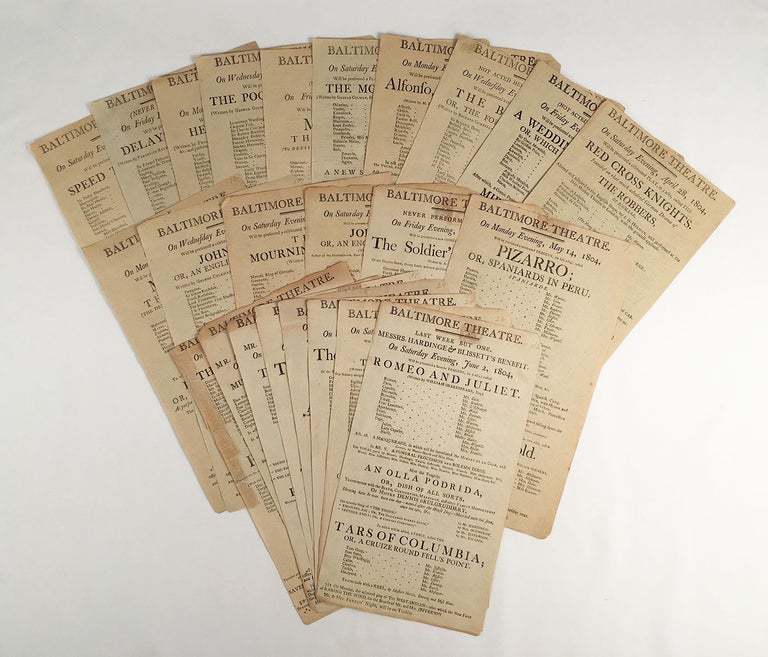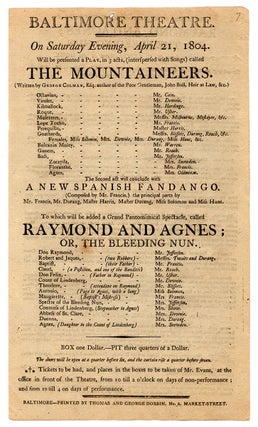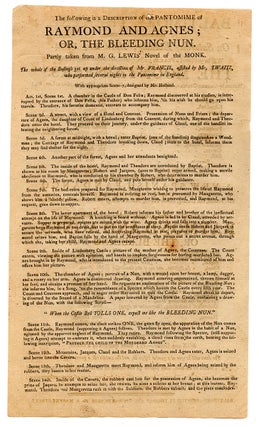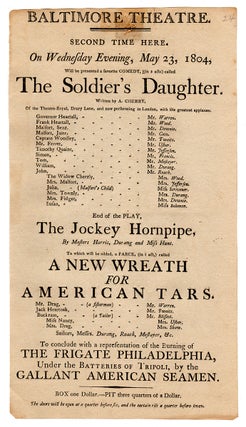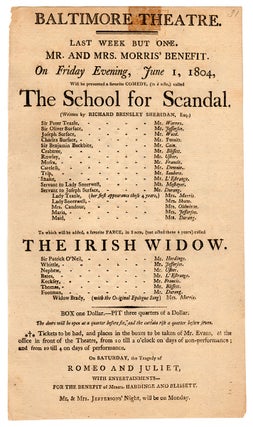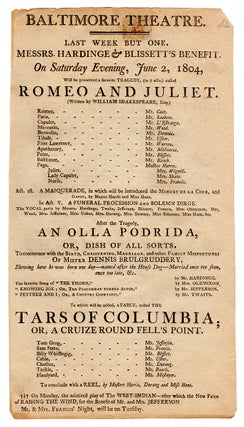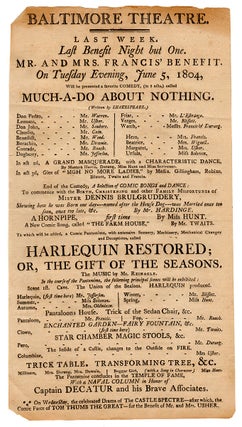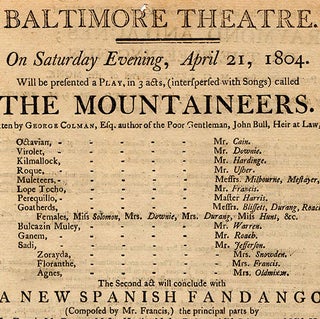A lot of twenty-four Baltimore Theatre playbills
Baltimore, 1804; performance dates from April 20, 1804 to June 2, 1804. 12 with imprint of Thomas and George Dobbin, No. 6 Market-Street; others lacking imprint but likely by the same printer. 24 broadsides on laid paper, each approx. 32 x 19 cm, two with brief annotations. An ample sheaf of twenty-four early nineteenth century playbills for the Baltimore Theatre, also known as the Holliday Street Theatre, all of them unrecorded. This remarkable gathering provides rich documentation of theatre life in Baltimore at the dawn of the nineteenth century, recording the titles of the many plays performed, the names of characters and actors, descriptions of the action and sets, and occasional content relating to the First Barbary War, as well as other military and patriotic themes. As was customary in the American theatre at this early date, the plays performed at the Baltimore Theatre were largely of British or European origin, as American playwriting was in its infancy. Represented here are Shakespeare’s Romeo and Juliet and Much Ado About Nothing, adaptations of Gothic tales, and some of the many comedies, tragedies, comic operas, farces, etc. popular at the time, but now largely forgotten. Perhaps the most notable of the Gothic plays is Raymond and Agnes; or the Bleeding Nun, a story lifted from Matthew Lewis’s popular novel The Monk (1796), described here, on three playbills, as “a grand pantomimical spectacle.” Two of these have a description of all 14 scenes on the verso. Other works by Lewis performed include Alfonso, King of Castile and Adelmorn, the Outlaw. Among the more notable playwrights represented are William Congreve (The Mourning Bride), Richard Brinsley Sheridan (The School for Scandal), and August von Kotzbue (Pizarro; or, Spaniards in Peru, adapted by Sheridan, and Of Age Tomorrow; or, Der Wildfang). Some of the most compelling entertainments described are the interludes and conclusions, which reflect contemporary preoccupations with patriotism, national security, and naval actions during the First Barbary War. These include such farces as A New Wreath for American Tars…to conclude with a representation of the Burning of the Frigate Philadelphia, Under the Batteries of Tripoli, by the Gallant American Seamen, and Tars of Columbia; or, a Cruize Round Fell’s Point, as well as a June 5, 1804 pantomime concluding “in the Temple of Fame, with a Naval Column in Honor of Captain Decatur and his Brave Associates.” Military spectacle was standard fare. Two of these playbills describe conclusions featuring “a perspective view of a Military Encampment, with a representation of the Troops Under Arms, Infantry, Cavalry, Artillery, &c.—Air and Chorus.” Baltimore was “one of the first towns in America to show hospitality to theatre companies” (Oxford Companion to the Theatre). In 1781, the first proper theater building was erected in town, a brick structure located on East Baltimore Street, and from that time forward Baltimore assumed an important place in the theatre life of the young nation. In 1792, actor Thomas Wignell (1753–1803), who had gained fame as a leading member of the “Old American Company,” formed a partnership with composer and theater musician Alexander Reinagle (1756–1809). The two began construction of new theaters in Philadelphia and Baltimore. The Baltimore Theatre was established in 1794 and opened to the public in September of 1795. With the death of Wignell in 1803, Reinagle became head of the musical department in Baltimore, and his compositions and adaptations, some of which are described in the playbills offered here, proved very popular with the public. Actors William Warren and William B. Wood, whose names appear on many of the playbills, managed and directed the theatre in this period. The Baltimore Theatre is perhaps best remembered for the historic role it played in the popularization of Francis Scott Key’s Star-Spangled Banner, which was first sung by Ferdinand Durang in a tavern adjacent to the (rebuilt) theatre in 1814. Following its first performance in the theatre by a Mr. Hardinge in October of 1814, as noted in the Federal Gazette, Durang and his brother Charlie, some sources say, began singing it in the theatre to great popular acclaim. From there it would eventually spread throughout the country. The Durang brothers and their parents were all actors in the Baltimore Theatre company. Their names appear frequently on these playbills. No trace of any of these playbills in OCLC. Not in Shaw & Shoemaker. The Maryland Historical Society has a bound volume of Baltimore Theatre playbills for the 1795 season, as well as bound volumes of playbills from 1809 on. A rare and entertaining gathering of early 19th century Baltimore playbills. Offered in partnership with Boston Rare Maps. REFERENCES: Scharf, John Thomas. History of Baltimore City and County, from the Earliest Period to the Present Day. Baltimore, 1881, pp. 680–686. CONDITION: Good, occasional old tape repairs on versos with corresponding stains on rectos; some trimmed close with probable loss of imprints in some cases, minor losses and short tears at edges.
Item #4878
Sold


